Cloud Computing's Role in Transforming Bangladesh Education System
VerifiedAdded on 2020/05/28
|14
|4080
|204
Report
AI Summary
This report analyzes the integration of cloud computing in Bangladesh's education sector, focusing on how ICT can enhance literacy and contribute to economic growth. It examines the government's 'Digital Bangladesh' initiative and the establishment of ICT networks in remote areas. The study reviews existing e-learning platforms, highlighting their limitations in providing robust and scalable education services. The proposed solution involves deploying cloud computing infrastructure, including desktops, laptops, and printers, to facilitate content delivery to both developed and remote areas. The report emphasizes the importance of user-friendly content accessible on various devices and the need for trained personnel and stable cloud services. It also addresses potential challenges such as financial constraints and resistance to technological adoption while comparing the proposed system's advantages over current ICT programs in education. The evaluation of the proposed solution considers the specifications of devices, network bandwidth, and content delivery to ensure effective and equal access to education across Bangladesh.
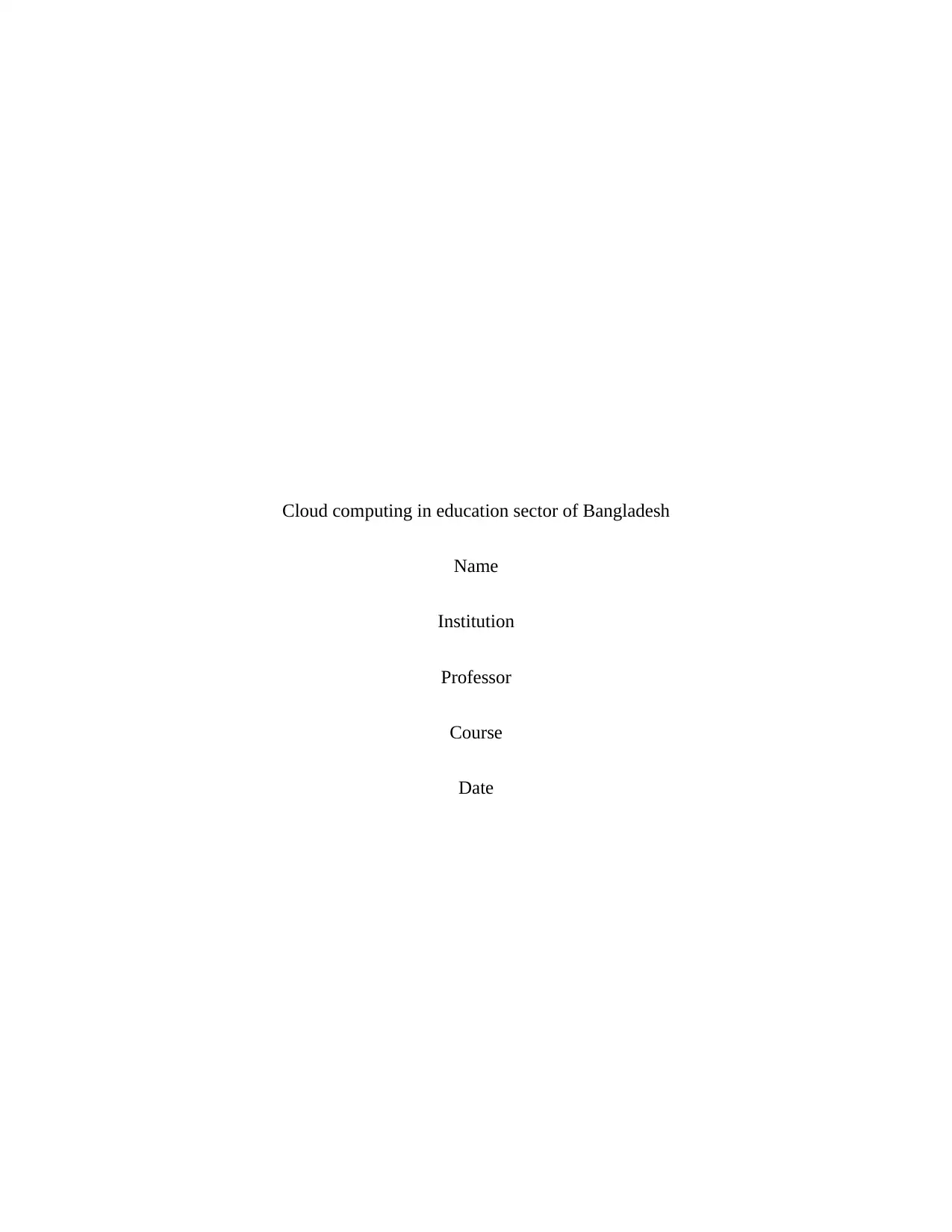
Cloud computing in education sector of Bangladesh
Name
Institution
Professor
Course
Date
Name
Institution
Professor
Course
Date
Paraphrase This Document
Need a fresh take? Get an instant paraphrase of this document with our AI Paraphraser
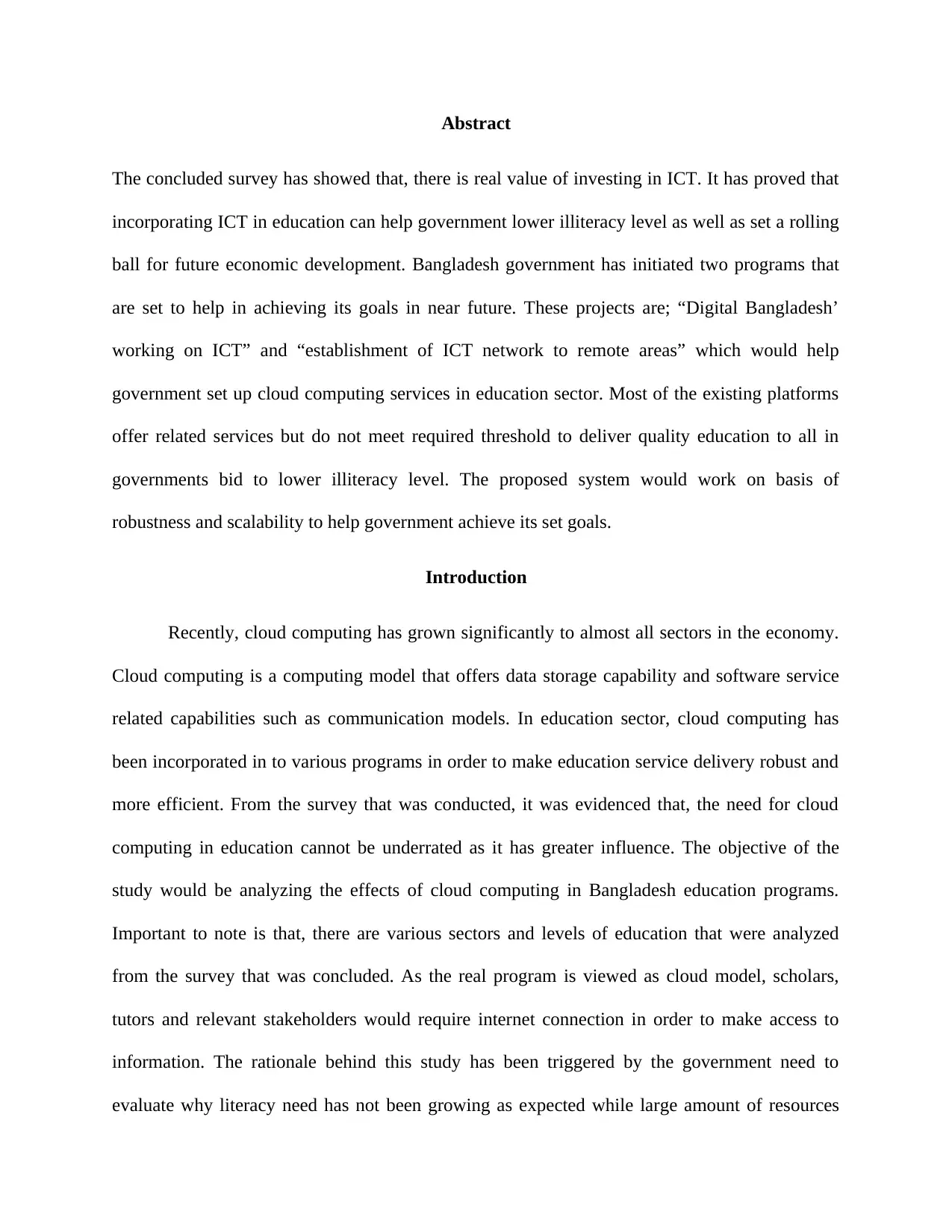
Abstract
The concluded survey has showed that, there is real value of investing in ICT. It has proved that
incorporating ICT in education can help government lower illiteracy level as well as set a rolling
ball for future economic development. Bangladesh government has initiated two programs that
are set to help in achieving its goals in near future. These projects are; “Digital Bangladesh’
working on ICT” and “establishment of ICT network to remote areas” which would help
government set up cloud computing services in education sector. Most of the existing platforms
offer related services but do not meet required threshold to deliver quality education to all in
governments bid to lower illiteracy level. The proposed system would work on basis of
robustness and scalability to help government achieve its set goals.
Introduction
Recently, cloud computing has grown significantly to almost all sectors in the economy.
Cloud computing is a computing model that offers data storage capability and software service
related capabilities such as communication models. In education sector, cloud computing has
been incorporated in to various programs in order to make education service delivery robust and
more efficient. From the survey that was conducted, it was evidenced that, the need for cloud
computing in education cannot be underrated as it has greater influence. The objective of the
study would be analyzing the effects of cloud computing in Bangladesh education programs.
Important to note is that, there are various sectors and levels of education that were analyzed
from the survey that was concluded. As the real program is viewed as cloud model, scholars,
tutors and relevant stakeholders would require internet connection in order to make access to
information. The rationale behind this study has been triggered by the government need to
evaluate why literacy need has not been growing as expected while large amount of resources
The concluded survey has showed that, there is real value of investing in ICT. It has proved that
incorporating ICT in education can help government lower illiteracy level as well as set a rolling
ball for future economic development. Bangladesh government has initiated two programs that
are set to help in achieving its goals in near future. These projects are; “Digital Bangladesh’
working on ICT” and “establishment of ICT network to remote areas” which would help
government set up cloud computing services in education sector. Most of the existing platforms
offer related services but do not meet required threshold to deliver quality education to all in
governments bid to lower illiteracy level. The proposed system would work on basis of
robustness and scalability to help government achieve its set goals.
Introduction
Recently, cloud computing has grown significantly to almost all sectors in the economy.
Cloud computing is a computing model that offers data storage capability and software service
related capabilities such as communication models. In education sector, cloud computing has
been incorporated in to various programs in order to make education service delivery robust and
more efficient. From the survey that was conducted, it was evidenced that, the need for cloud
computing in education cannot be underrated as it has greater influence. The objective of the
study would be analyzing the effects of cloud computing in Bangladesh education programs.
Important to note is that, there are various sectors and levels of education that were analyzed
from the survey that was concluded. As the real program is viewed as cloud model, scholars,
tutors and relevant stakeholders would require internet connection in order to make access to
information. The rationale behind this study has been triggered by the government need to
evaluate why literacy need has not been growing as expected while large amount of resources
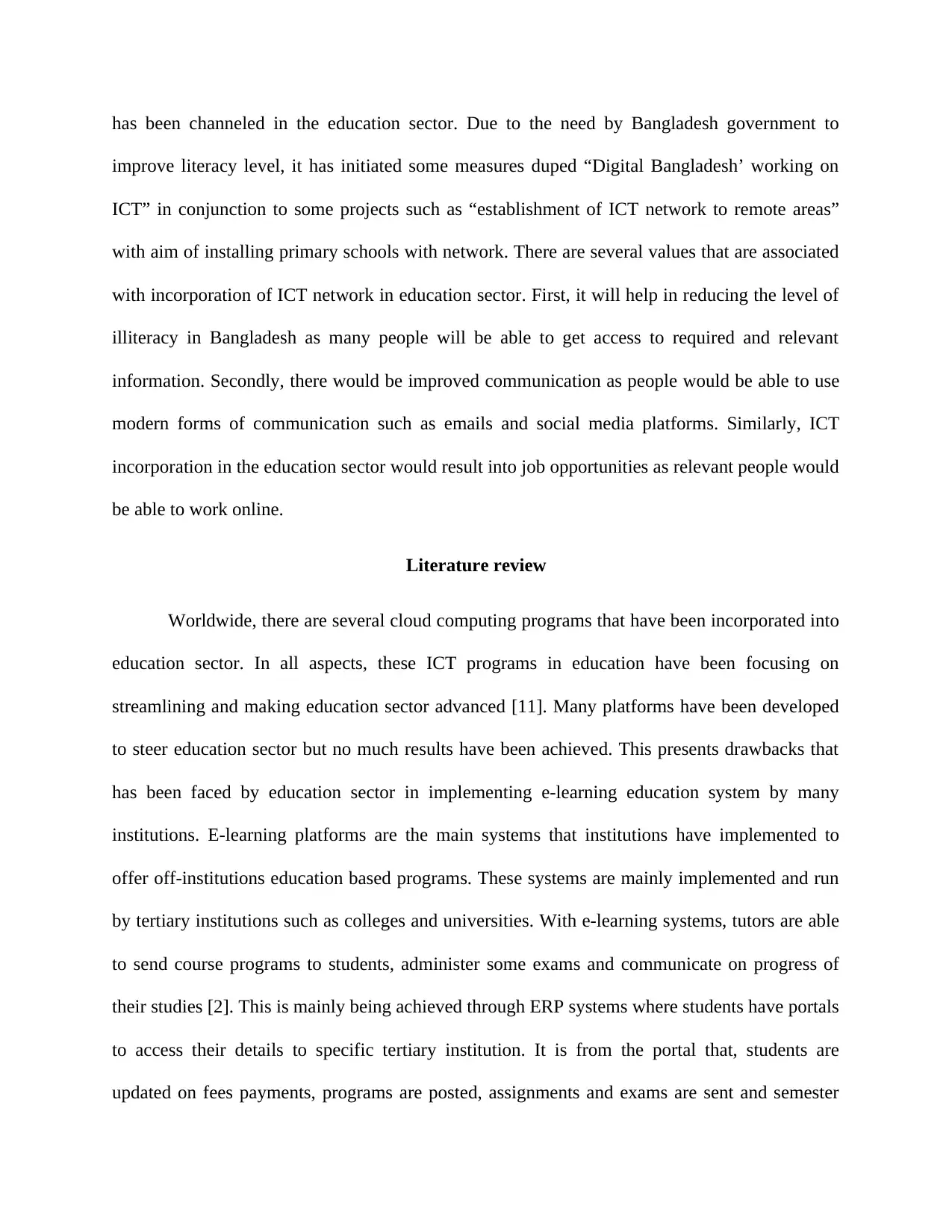
has been channeled in the education sector. Due to the need by Bangladesh government to
improve literacy level, it has initiated some measures duped “Digital Bangladesh’ working on
ICT” in conjunction to some projects such as “establishment of ICT network to remote areas”
with aim of installing primary schools with network. There are several values that are associated
with incorporation of ICT network in education sector. First, it will help in reducing the level of
illiteracy in Bangladesh as many people will be able to get access to required and relevant
information. Secondly, there would be improved communication as people would be able to use
modern forms of communication such as emails and social media platforms. Similarly, ICT
incorporation in the education sector would result into job opportunities as relevant people would
be able to work online.
Literature review
Worldwide, there are several cloud computing programs that have been incorporated into
education sector. In all aspects, these ICT programs in education have been focusing on
streamlining and making education sector advanced [11]. Many platforms have been developed
to steer education sector but no much results have been achieved. This presents drawbacks that
has been faced by education sector in implementing e-learning education system by many
institutions. E-learning platforms are the main systems that institutions have implemented to
offer off-institutions education based programs. These systems are mainly implemented and run
by tertiary institutions such as colleges and universities. With e-learning systems, tutors are able
to send course programs to students, administer some exams and communicate on progress of
their studies [2]. This is mainly being achieved through ERP systems where students have portals
to access their details to specific tertiary institution. It is from the portal that, students are
updated on fees payments, programs are posted, assignments and exams are sent and semester
improve literacy level, it has initiated some measures duped “Digital Bangladesh’ working on
ICT” in conjunction to some projects such as “establishment of ICT network to remote areas”
with aim of installing primary schools with network. There are several values that are associated
with incorporation of ICT network in education sector. First, it will help in reducing the level of
illiteracy in Bangladesh as many people will be able to get access to required and relevant
information. Secondly, there would be improved communication as people would be able to use
modern forms of communication such as emails and social media platforms. Similarly, ICT
incorporation in the education sector would result into job opportunities as relevant people would
be able to work online.
Literature review
Worldwide, there are several cloud computing programs that have been incorporated into
education sector. In all aspects, these ICT programs in education have been focusing on
streamlining and making education sector advanced [11]. Many platforms have been developed
to steer education sector but no much results have been achieved. This presents drawbacks that
has been faced by education sector in implementing e-learning education system by many
institutions. E-learning platforms are the main systems that institutions have implemented to
offer off-institutions education based programs. These systems are mainly implemented and run
by tertiary institutions such as colleges and universities. With e-learning systems, tutors are able
to send course programs to students, administer some exams and communicate on progress of
their studies [2]. This is mainly being achieved through ERP systems where students have portals
to access their details to specific tertiary institution. It is from the portal that, students are
updated on fees payments, programs are posted, assignments and exams are sent and semester
⊘ This is a preview!⊘
Do you want full access?
Subscribe today to unlock all pages.

Trusted by 1+ million students worldwide
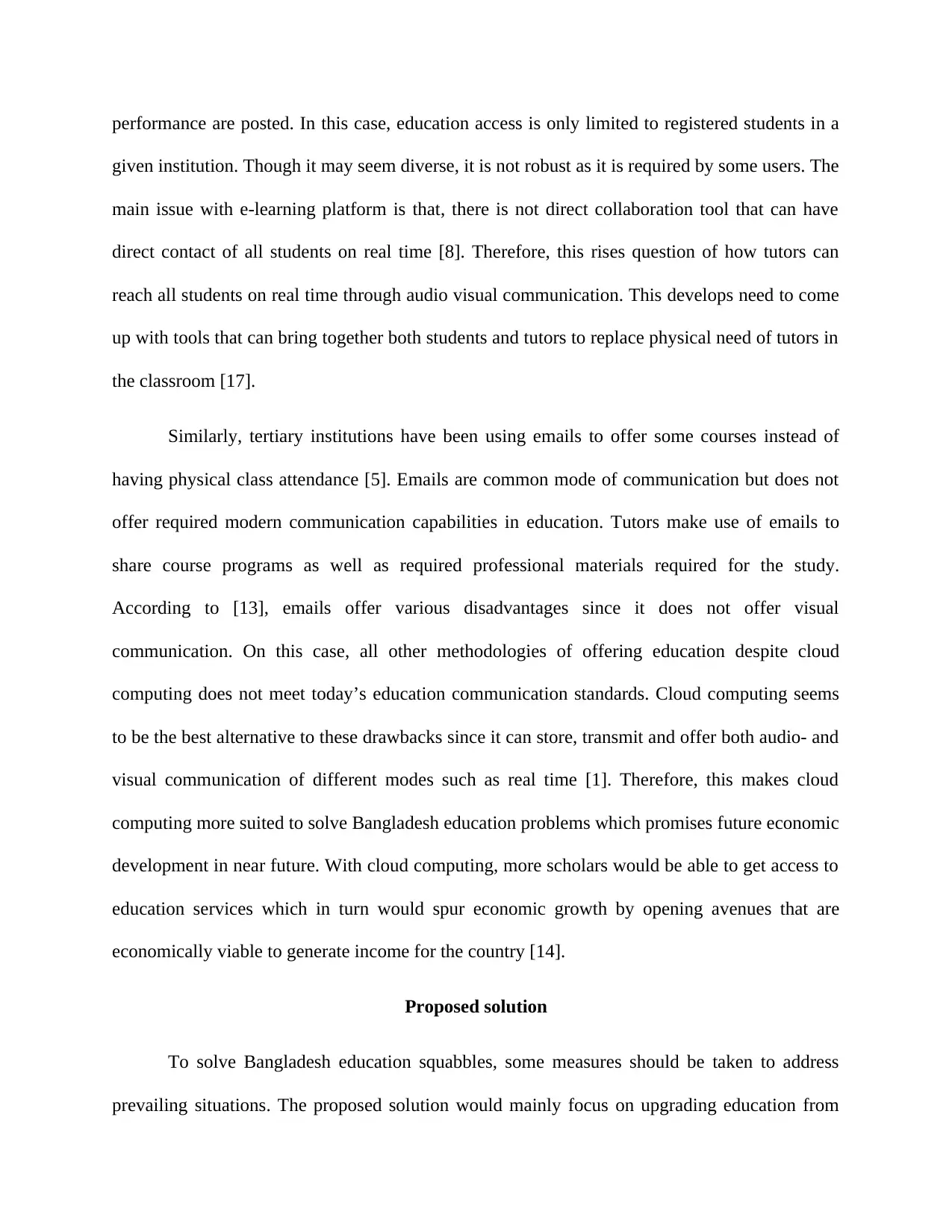
performance are posted. In this case, education access is only limited to registered students in a
given institution. Though it may seem diverse, it is not robust as it is required by some users. The
main issue with e-learning platform is that, there is not direct collaboration tool that can have
direct contact of all students on real time [8]. Therefore, this rises question of how tutors can
reach all students on real time through audio visual communication. This develops need to come
up with tools that can bring together both students and tutors to replace physical need of tutors in
the classroom [17].
Similarly, tertiary institutions have been using emails to offer some courses instead of
having physical class attendance [5]. Emails are common mode of communication but does not
offer required modern communication capabilities in education. Tutors make use of emails to
share course programs as well as required professional materials required for the study.
According to [13], emails offer various disadvantages since it does not offer visual
communication. On this case, all other methodologies of offering education despite cloud
computing does not meet today’s education communication standards. Cloud computing seems
to be the best alternative to these drawbacks since it can store, transmit and offer both audio- and
visual communication of different modes such as real time [1]. Therefore, this makes cloud
computing more suited to solve Bangladesh education problems which promises future economic
development in near future. With cloud computing, more scholars would be able to get access to
education services which in turn would spur economic growth by opening avenues that are
economically viable to generate income for the country [14].
Proposed solution
To solve Bangladesh education squabbles, some measures should be taken to address
prevailing situations. The proposed solution would mainly focus on upgrading education from
given institution. Though it may seem diverse, it is not robust as it is required by some users. The
main issue with e-learning platform is that, there is not direct collaboration tool that can have
direct contact of all students on real time [8]. Therefore, this rises question of how tutors can
reach all students on real time through audio visual communication. This develops need to come
up with tools that can bring together both students and tutors to replace physical need of tutors in
the classroom [17].
Similarly, tertiary institutions have been using emails to offer some courses instead of
having physical class attendance [5]. Emails are common mode of communication but does not
offer required modern communication capabilities in education. Tutors make use of emails to
share course programs as well as required professional materials required for the study.
According to [13], emails offer various disadvantages since it does not offer visual
communication. On this case, all other methodologies of offering education despite cloud
computing does not meet today’s education communication standards. Cloud computing seems
to be the best alternative to these drawbacks since it can store, transmit and offer both audio- and
visual communication of different modes such as real time [1]. Therefore, this makes cloud
computing more suited to solve Bangladesh education problems which promises future economic
development in near future. With cloud computing, more scholars would be able to get access to
education services which in turn would spur economic growth by opening avenues that are
economically viable to generate income for the country [14].
Proposed solution
To solve Bangladesh education squabbles, some measures should be taken to address
prevailing situations. The proposed solution would mainly focus on upgrading education from
Paraphrase This Document
Need a fresh take? Get an instant paraphrase of this document with our AI Paraphraser
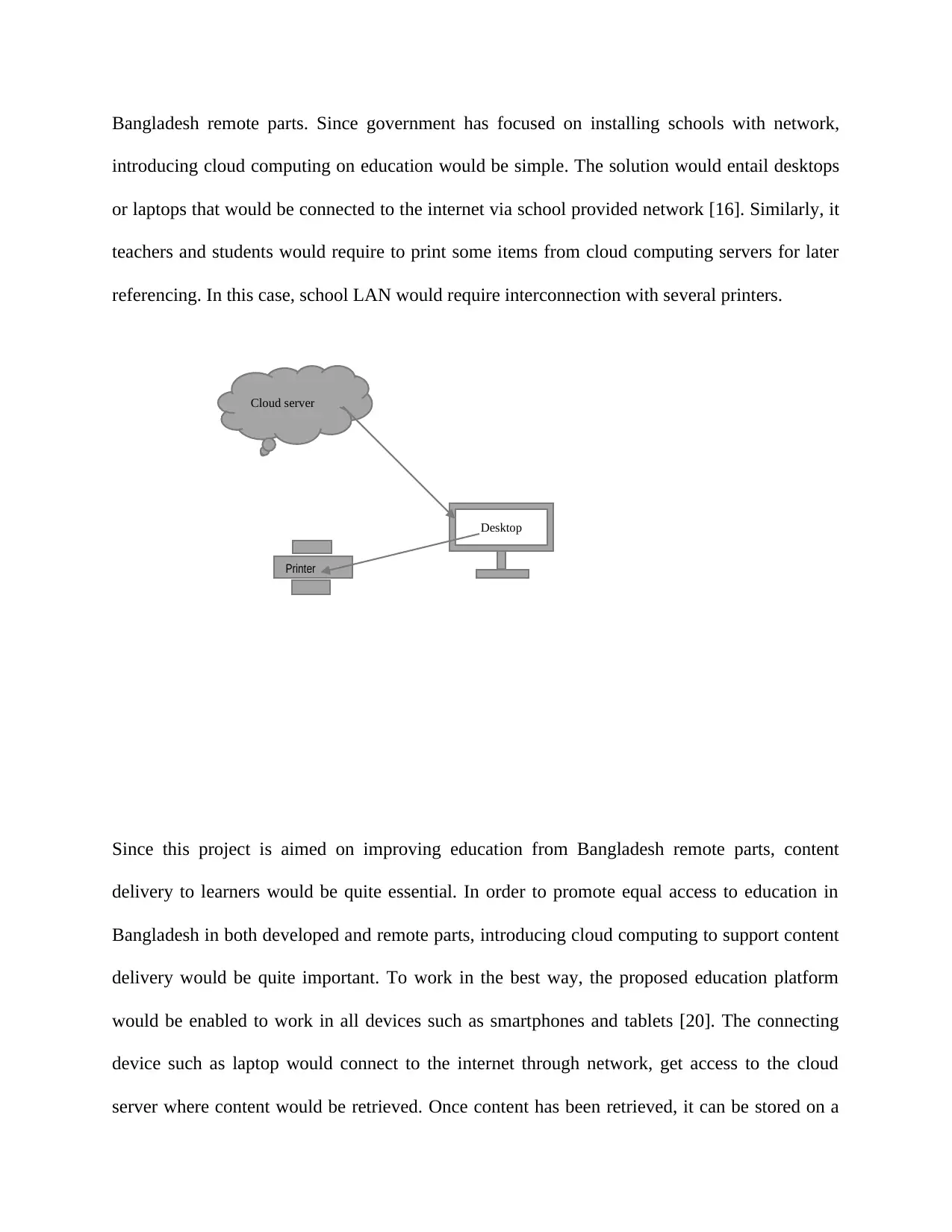
Bangladesh remote parts. Since government has focused on installing schools with network,
introducing cloud computing on education would be simple. The solution would entail desktops
or laptops that would be connected to the internet via school provided network [16]. Similarly, it
teachers and students would require to print some items from cloud computing servers for later
referencing. In this case, school LAN would require interconnection with several printers.
Since this project is aimed on improving education from Bangladesh remote parts, content
delivery to learners would be quite essential. In order to promote equal access to education in
Bangladesh in both developed and remote parts, introducing cloud computing to support content
delivery would be quite important. To work in the best way, the proposed education platform
would be enabled to work in all devices such as smartphones and tablets [20]. The connecting
device such as laptop would connect to the internet through network, get access to the cloud
server where content would be retrieved. Once content has been retrieved, it can be stored on a
Printer
Desktop
Cloud server
introducing cloud computing on education would be simple. The solution would entail desktops
or laptops that would be connected to the internet via school provided network [16]. Similarly, it
teachers and students would require to print some items from cloud computing servers for later
referencing. In this case, school LAN would require interconnection with several printers.
Since this project is aimed on improving education from Bangladesh remote parts, content
delivery to learners would be quite essential. In order to promote equal access to education in
Bangladesh in both developed and remote parts, introducing cloud computing to support content
delivery would be quite important. To work in the best way, the proposed education platform
would be enabled to work in all devices such as smartphones and tablets [20]. The connecting
device such as laptop would connect to the internet through network, get access to the cloud
server where content would be retrieved. Once content has been retrieved, it can be stored on a
Printer
Desktop
Cloud server
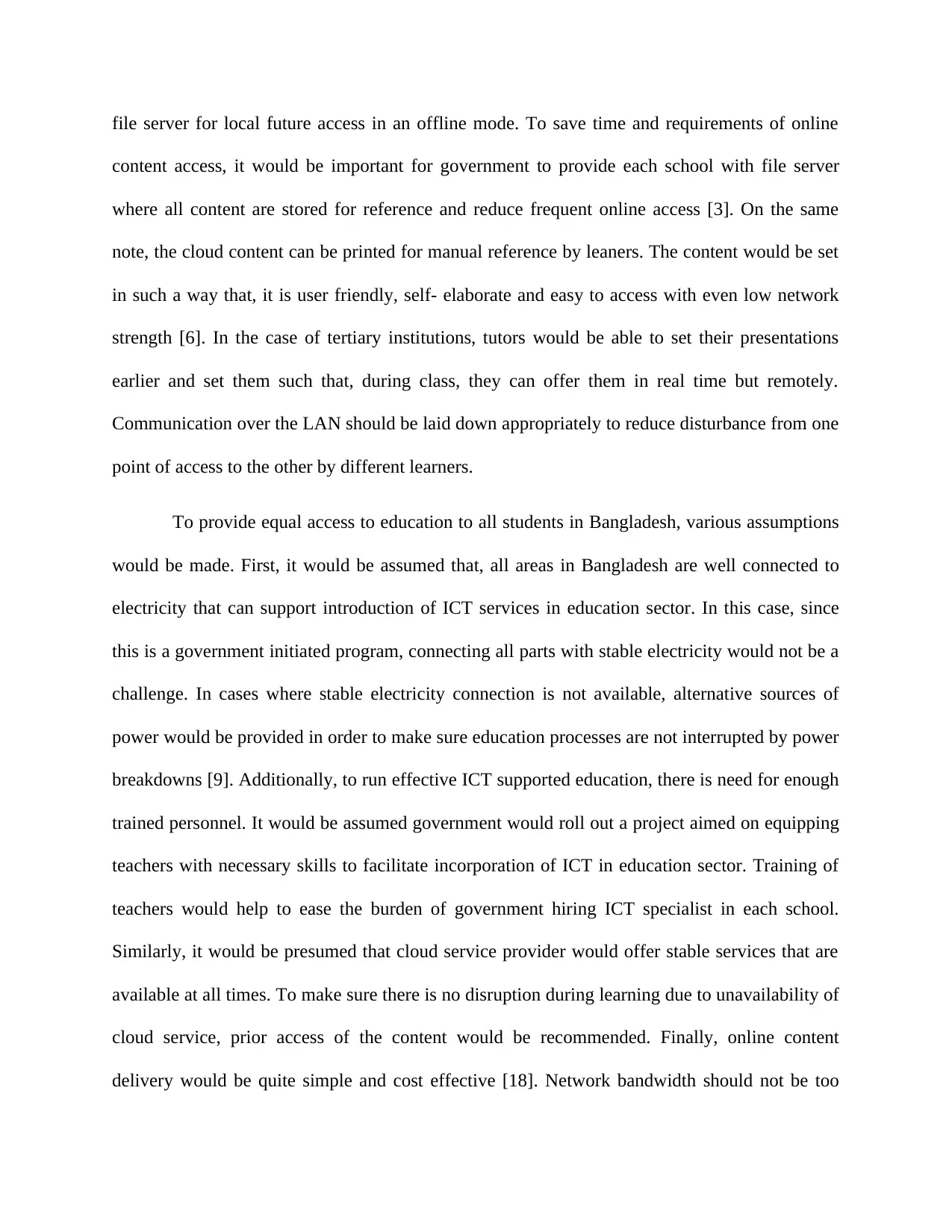
file server for local future access in an offline mode. To save time and requirements of online
content access, it would be important for government to provide each school with file server
where all content are stored for reference and reduce frequent online access [3]. On the same
note, the cloud content can be printed for manual reference by leaners. The content would be set
in such a way that, it is user friendly, self- elaborate and easy to access with even low network
strength [6]. In the case of tertiary institutions, tutors would be able to set their presentations
earlier and set them such that, during class, they can offer them in real time but remotely.
Communication over the LAN should be laid down appropriately to reduce disturbance from one
point of access to the other by different learners.
To provide equal access to education to all students in Bangladesh, various assumptions
would be made. First, it would be assumed that, all areas in Bangladesh are well connected to
electricity that can support introduction of ICT services in education sector. In this case, since
this is a government initiated program, connecting all parts with stable electricity would not be a
challenge. In cases where stable electricity connection is not available, alternative sources of
power would be provided in order to make sure education processes are not interrupted by power
breakdowns [9]. Additionally, to run effective ICT supported education, there is need for enough
trained personnel. It would be assumed government would roll out a project aimed on equipping
teachers with necessary skills to facilitate incorporation of ICT in education sector. Training of
teachers would help to ease the burden of government hiring ICT specialist in each school.
Similarly, it would be presumed that cloud service provider would offer stable services that are
available at all times. To make sure there is no disruption during learning due to unavailability of
cloud service, prior access of the content would be recommended. Finally, online content
delivery would be quite simple and cost effective [18]. Network bandwidth should not be too
content access, it would be important for government to provide each school with file server
where all content are stored for reference and reduce frequent online access [3]. On the same
note, the cloud content can be printed for manual reference by leaners. The content would be set
in such a way that, it is user friendly, self- elaborate and easy to access with even low network
strength [6]. In the case of tertiary institutions, tutors would be able to set their presentations
earlier and set them such that, during class, they can offer them in real time but remotely.
Communication over the LAN should be laid down appropriately to reduce disturbance from one
point of access to the other by different learners.
To provide equal access to education to all students in Bangladesh, various assumptions
would be made. First, it would be assumed that, all areas in Bangladesh are well connected to
electricity that can support introduction of ICT services in education sector. In this case, since
this is a government initiated program, connecting all parts with stable electricity would not be a
challenge. In cases where stable electricity connection is not available, alternative sources of
power would be provided in order to make sure education processes are not interrupted by power
breakdowns [9]. Additionally, to run effective ICT supported education, there is need for enough
trained personnel. It would be assumed government would roll out a project aimed on equipping
teachers with necessary skills to facilitate incorporation of ICT in education sector. Training of
teachers would help to ease the burden of government hiring ICT specialist in each school.
Similarly, it would be presumed that cloud service provider would offer stable services that are
available at all times. To make sure there is no disruption during learning due to unavailability of
cloud service, prior access of the content would be recommended. Finally, online content
delivery would be quite simple and cost effective [18]. Network bandwidth should not be too
⊘ This is a preview!⊘
Do you want full access?
Subscribe today to unlock all pages.

Trusted by 1+ million students worldwide
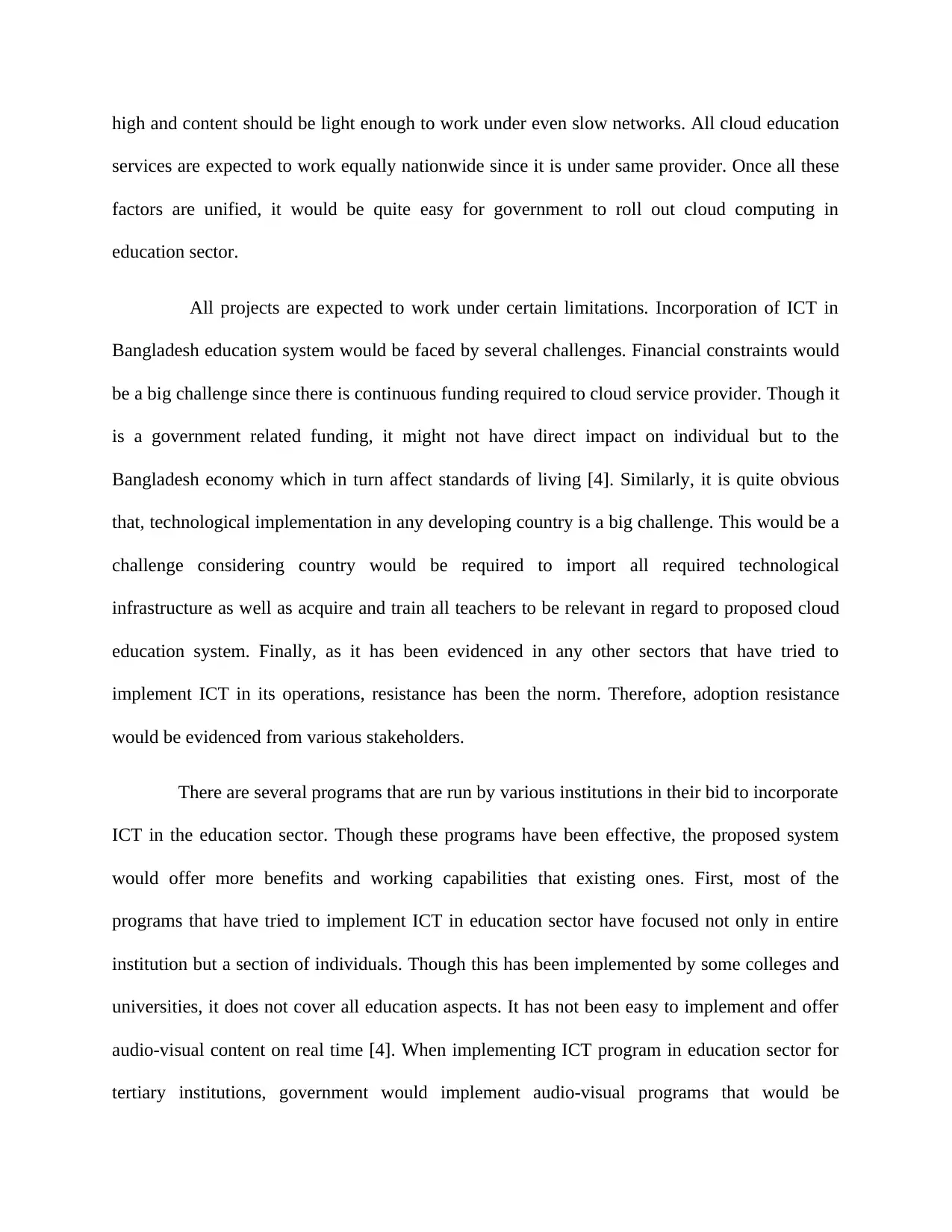
high and content should be light enough to work under even slow networks. All cloud education
services are expected to work equally nationwide since it is under same provider. Once all these
factors are unified, it would be quite easy for government to roll out cloud computing in
education sector.
All projects are expected to work under certain limitations. Incorporation of ICT in
Bangladesh education system would be faced by several challenges. Financial constraints would
be a big challenge since there is continuous funding required to cloud service provider. Though it
is a government related funding, it might not have direct impact on individual but to the
Bangladesh economy which in turn affect standards of living [4]. Similarly, it is quite obvious
that, technological implementation in any developing country is a big challenge. This would be a
challenge considering country would be required to import all required technological
infrastructure as well as acquire and train all teachers to be relevant in regard to proposed cloud
education system. Finally, as it has been evidenced in any other sectors that have tried to
implement ICT in its operations, resistance has been the norm. Therefore, adoption resistance
would be evidenced from various stakeholders.
There are several programs that are run by various institutions in their bid to incorporate
ICT in the education sector. Though these programs have been effective, the proposed system
would offer more benefits and working capabilities that existing ones. First, most of the
programs that have tried to implement ICT in education sector have focused not only in entire
institution but a section of individuals. Though this has been implemented by some colleges and
universities, it does not cover all education aspects. It has not been easy to implement and offer
audio-visual content on real time [4]. When implementing ICT program in education sector for
tertiary institutions, government would implement audio-visual programs that would be
services are expected to work equally nationwide since it is under same provider. Once all these
factors are unified, it would be quite easy for government to roll out cloud computing in
education sector.
All projects are expected to work under certain limitations. Incorporation of ICT in
Bangladesh education system would be faced by several challenges. Financial constraints would
be a big challenge since there is continuous funding required to cloud service provider. Though it
is a government related funding, it might not have direct impact on individual but to the
Bangladesh economy which in turn affect standards of living [4]. Similarly, it is quite obvious
that, technological implementation in any developing country is a big challenge. This would be a
challenge considering country would be required to import all required technological
infrastructure as well as acquire and train all teachers to be relevant in regard to proposed cloud
education system. Finally, as it has been evidenced in any other sectors that have tried to
implement ICT in its operations, resistance has been the norm. Therefore, adoption resistance
would be evidenced from various stakeholders.
There are several programs that are run by various institutions in their bid to incorporate
ICT in the education sector. Though these programs have been effective, the proposed system
would offer more benefits and working capabilities that existing ones. First, most of the
programs that have tried to implement ICT in education sector have focused not only in entire
institution but a section of individuals. Though this has been implemented by some colleges and
universities, it does not cover all education aspects. It has not been easy to implement and offer
audio-visual content on real time [4]. When implementing ICT program in education sector for
tertiary institutions, government would implement audio-visual programs that would be
Paraphrase This Document
Need a fresh take? Get an instant paraphrase of this document with our AI Paraphraser
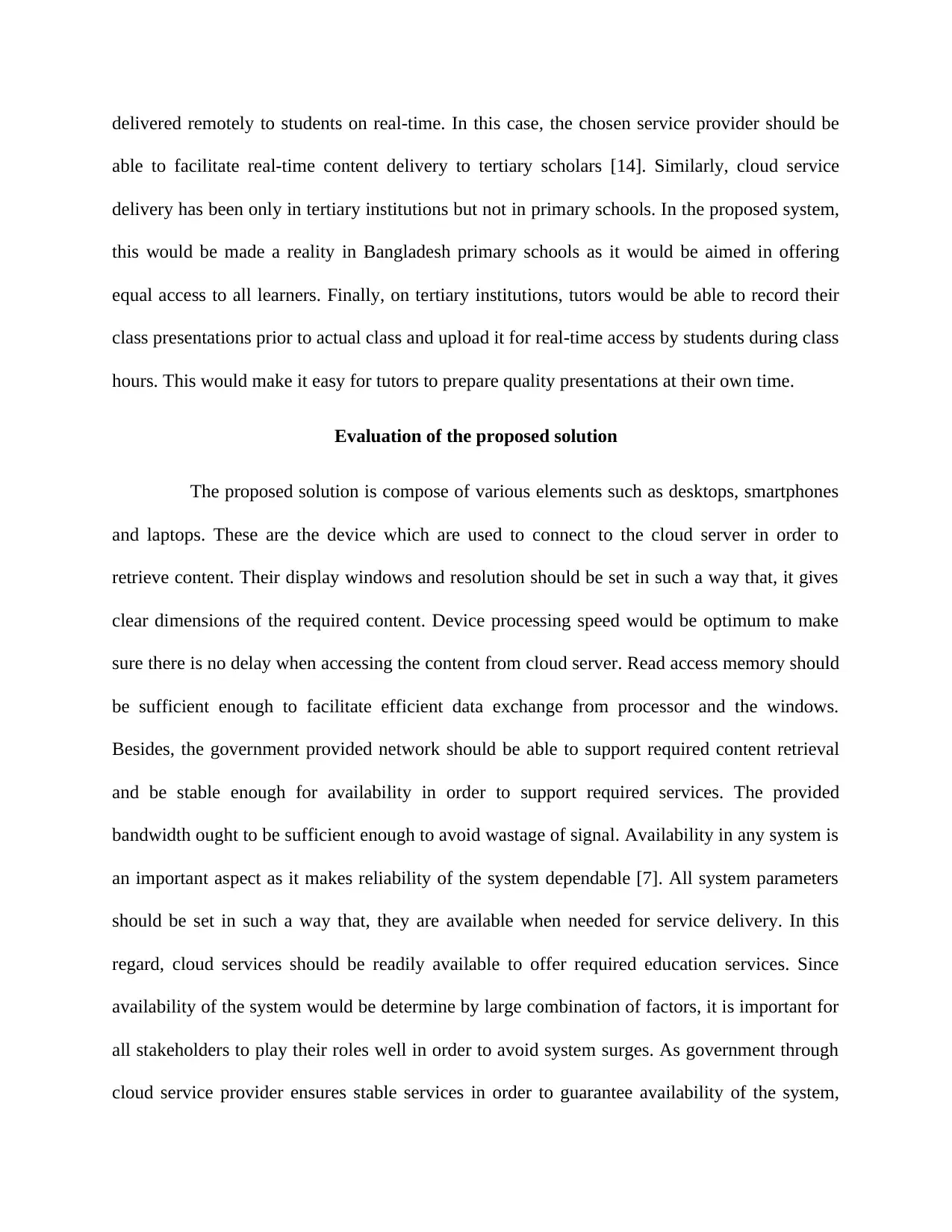
delivered remotely to students on real-time. In this case, the chosen service provider should be
able to facilitate real-time content delivery to tertiary scholars [14]. Similarly, cloud service
delivery has been only in tertiary institutions but not in primary schools. In the proposed system,
this would be made a reality in Bangladesh primary schools as it would be aimed in offering
equal access to all learners. Finally, on tertiary institutions, tutors would be able to record their
class presentations prior to actual class and upload it for real-time access by students during class
hours. This would make it easy for tutors to prepare quality presentations at their own time.
Evaluation of the proposed solution
The proposed solution is compose of various elements such as desktops, smartphones
and laptops. These are the device which are used to connect to the cloud server in order to
retrieve content. Their display windows and resolution should be set in such a way that, it gives
clear dimensions of the required content. Device processing speed would be optimum to make
sure there is no delay when accessing the content from cloud server. Read access memory should
be sufficient enough to facilitate efficient data exchange from processor and the windows.
Besides, the government provided network should be able to support required content retrieval
and be stable enough for availability in order to support required services. The provided
bandwidth ought to be sufficient enough to avoid wastage of signal. Availability in any system is
an important aspect as it makes reliability of the system dependable [7]. All system parameters
should be set in such a way that, they are available when needed for service delivery. In this
regard, cloud services should be readily available to offer required education services. Since
availability of the system would be determine by large combination of factors, it is important for
all stakeholders to play their roles well in order to avoid system surges. As government through
cloud service provider ensures stable services in order to guarantee availability of the system,
able to facilitate real-time content delivery to tertiary scholars [14]. Similarly, cloud service
delivery has been only in tertiary institutions but not in primary schools. In the proposed system,
this would be made a reality in Bangladesh primary schools as it would be aimed in offering
equal access to all learners. Finally, on tertiary institutions, tutors would be able to record their
class presentations prior to actual class and upload it for real-time access by students during class
hours. This would make it easy for tutors to prepare quality presentations at their own time.
Evaluation of the proposed solution
The proposed solution is compose of various elements such as desktops, smartphones
and laptops. These are the device which are used to connect to the cloud server in order to
retrieve content. Their display windows and resolution should be set in such a way that, it gives
clear dimensions of the required content. Device processing speed would be optimum to make
sure there is no delay when accessing the content from cloud server. Read access memory should
be sufficient enough to facilitate efficient data exchange from processor and the windows.
Besides, the government provided network should be able to support required content retrieval
and be stable enough for availability in order to support required services. The provided
bandwidth ought to be sufficient enough to avoid wastage of signal. Availability in any system is
an important aspect as it makes reliability of the system dependable [7]. All system parameters
should be set in such a way that, they are available when needed for service delivery. In this
regard, cloud services should be readily available to offer required education services. Since
availability of the system would be determine by large combination of factors, it is important for
all stakeholders to play their roles well in order to avoid system surges. As government through
cloud service provider ensures stable services in order to guarantee availability of the system,
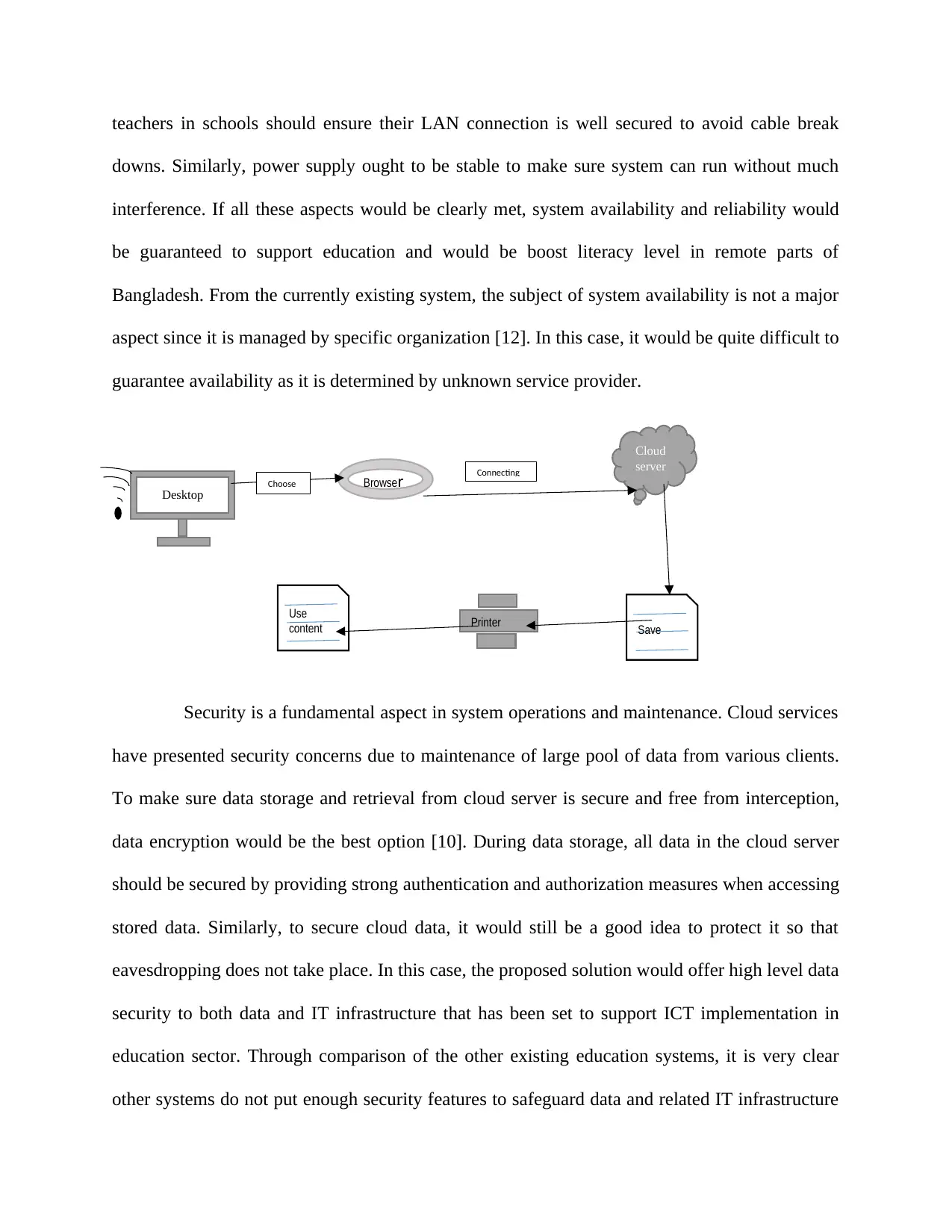
teachers in schools should ensure their LAN connection is well secured to avoid cable break
downs. Similarly, power supply ought to be stable to make sure system can run without much
interference. If all these aspects would be clearly met, system availability and reliability would
be guaranteed to support education and would be boost literacy level in remote parts of
Bangladesh. From the currently existing system, the subject of system availability is not a major
aspect since it is managed by specific organization [12]. In this case, it would be quite difficult to
guarantee availability as it is determined by unknown service provider.
Security is a fundamental aspect in system operations and maintenance. Cloud services
have presented security concerns due to maintenance of large pool of data from various clients.
To make sure data storage and retrieval from cloud server is secure and free from interception,
data encryption would be the best option [10]. During data storage, all data in the cloud server
should be secured by providing strong authentication and authorization measures when accessing
stored data. Similarly, to secure cloud data, it would still be a good idea to protect it so that
eavesdropping does not take place. In this case, the proposed solution would offer high level data
security to both data and IT infrastructure that has been set to support ICT implementation in
education sector. Through comparison of the other existing education systems, it is very clear
other systems do not put enough security features to safeguard data and related IT infrastructure
Cloud
serverConnecting
Choose
Use
content Save
Browser
Printer
Desktop
downs. Similarly, power supply ought to be stable to make sure system can run without much
interference. If all these aspects would be clearly met, system availability and reliability would
be guaranteed to support education and would be boost literacy level in remote parts of
Bangladesh. From the currently existing system, the subject of system availability is not a major
aspect since it is managed by specific organization [12]. In this case, it would be quite difficult to
guarantee availability as it is determined by unknown service provider.
Security is a fundamental aspect in system operations and maintenance. Cloud services
have presented security concerns due to maintenance of large pool of data from various clients.
To make sure data storage and retrieval from cloud server is secure and free from interception,
data encryption would be the best option [10]. During data storage, all data in the cloud server
should be secured by providing strong authentication and authorization measures when accessing
stored data. Similarly, to secure cloud data, it would still be a good idea to protect it so that
eavesdropping does not take place. In this case, the proposed solution would offer high level data
security to both data and IT infrastructure that has been set to support ICT implementation in
education sector. Through comparison of the other existing education systems, it is very clear
other systems do not put enough security features to safeguard data and related IT infrastructure
Cloud
serverConnecting
Choose
Use
content Save
Browser
Printer
Desktop
⊘ This is a preview!⊘
Do you want full access?
Subscribe today to unlock all pages.

Trusted by 1+ million students worldwide
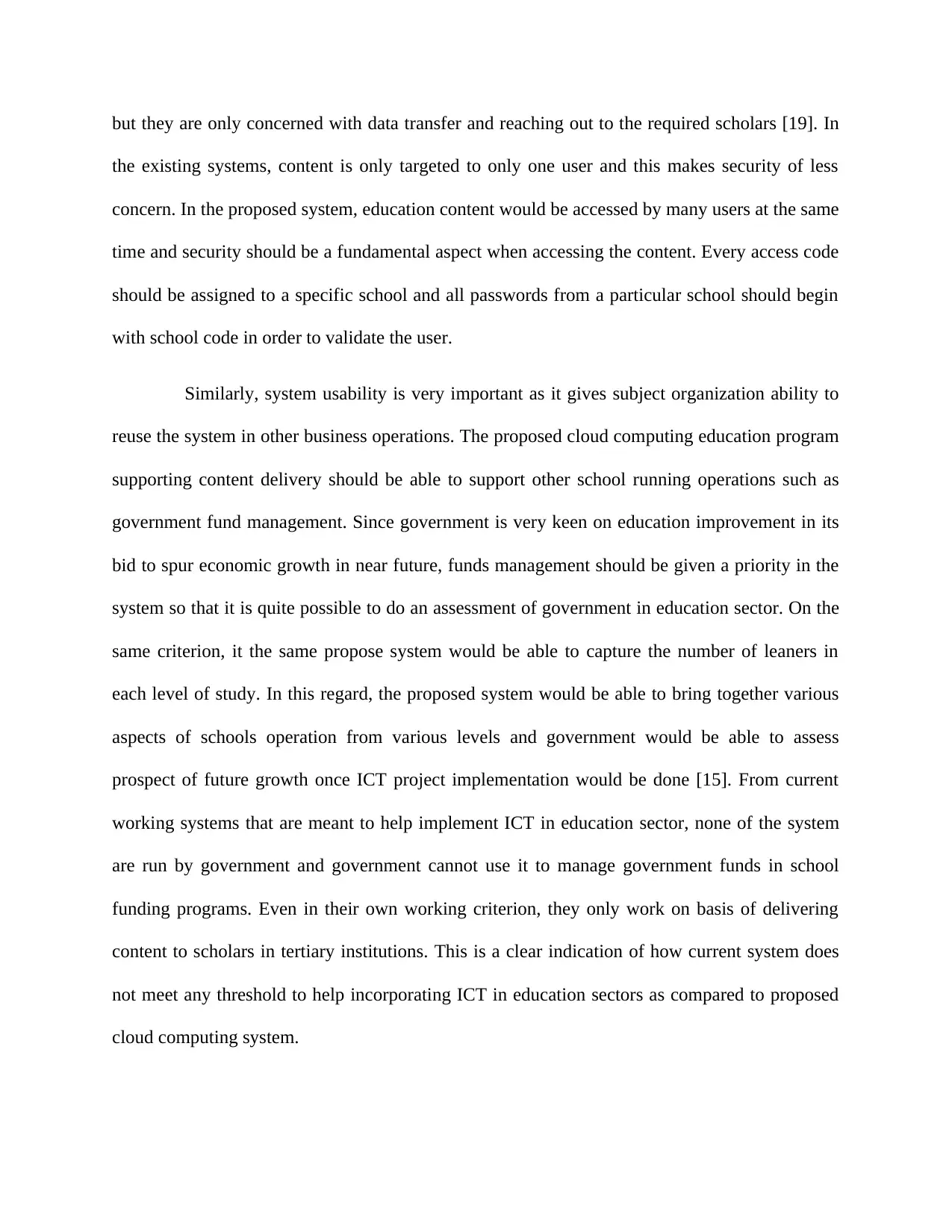
but they are only concerned with data transfer and reaching out to the required scholars [19]. In
the existing systems, content is only targeted to only one user and this makes security of less
concern. In the proposed system, education content would be accessed by many users at the same
time and security should be a fundamental aspect when accessing the content. Every access code
should be assigned to a specific school and all passwords from a particular school should begin
with school code in order to validate the user.
Similarly, system usability is very important as it gives subject organization ability to
reuse the system in other business operations. The proposed cloud computing education program
supporting content delivery should be able to support other school running operations such as
government fund management. Since government is very keen on education improvement in its
bid to spur economic growth in near future, funds management should be given a priority in the
system so that it is quite possible to do an assessment of government in education sector. On the
same criterion, it the same propose system would be able to capture the number of leaners in
each level of study. In this regard, the proposed system would be able to bring together various
aspects of schools operation from various levels and government would be able to assess
prospect of future growth once ICT project implementation would be done [15]. From current
working systems that are meant to help implement ICT in education sector, none of the system
are run by government and government cannot use it to manage government funds in school
funding programs. Even in their own working criterion, they only work on basis of delivering
content to scholars in tertiary institutions. This is a clear indication of how current system does
not meet any threshold to help incorporating ICT in education sectors as compared to proposed
cloud computing system.
the existing systems, content is only targeted to only one user and this makes security of less
concern. In the proposed system, education content would be accessed by many users at the same
time and security should be a fundamental aspect when accessing the content. Every access code
should be assigned to a specific school and all passwords from a particular school should begin
with school code in order to validate the user.
Similarly, system usability is very important as it gives subject organization ability to
reuse the system in other business operations. The proposed cloud computing education program
supporting content delivery should be able to support other school running operations such as
government fund management. Since government is very keen on education improvement in its
bid to spur economic growth in near future, funds management should be given a priority in the
system so that it is quite possible to do an assessment of government in education sector. On the
same criterion, it the same propose system would be able to capture the number of leaners in
each level of study. In this regard, the proposed system would be able to bring together various
aspects of schools operation from various levels and government would be able to assess
prospect of future growth once ICT project implementation would be done [15]. From current
working systems that are meant to help implement ICT in education sector, none of the system
are run by government and government cannot use it to manage government funds in school
funding programs. Even in their own working criterion, they only work on basis of delivering
content to scholars in tertiary institutions. This is a clear indication of how current system does
not meet any threshold to help incorporating ICT in education sectors as compared to proposed
cloud computing system.
Paraphrase This Document
Need a fresh take? Get an instant paraphrase of this document with our AI Paraphraser
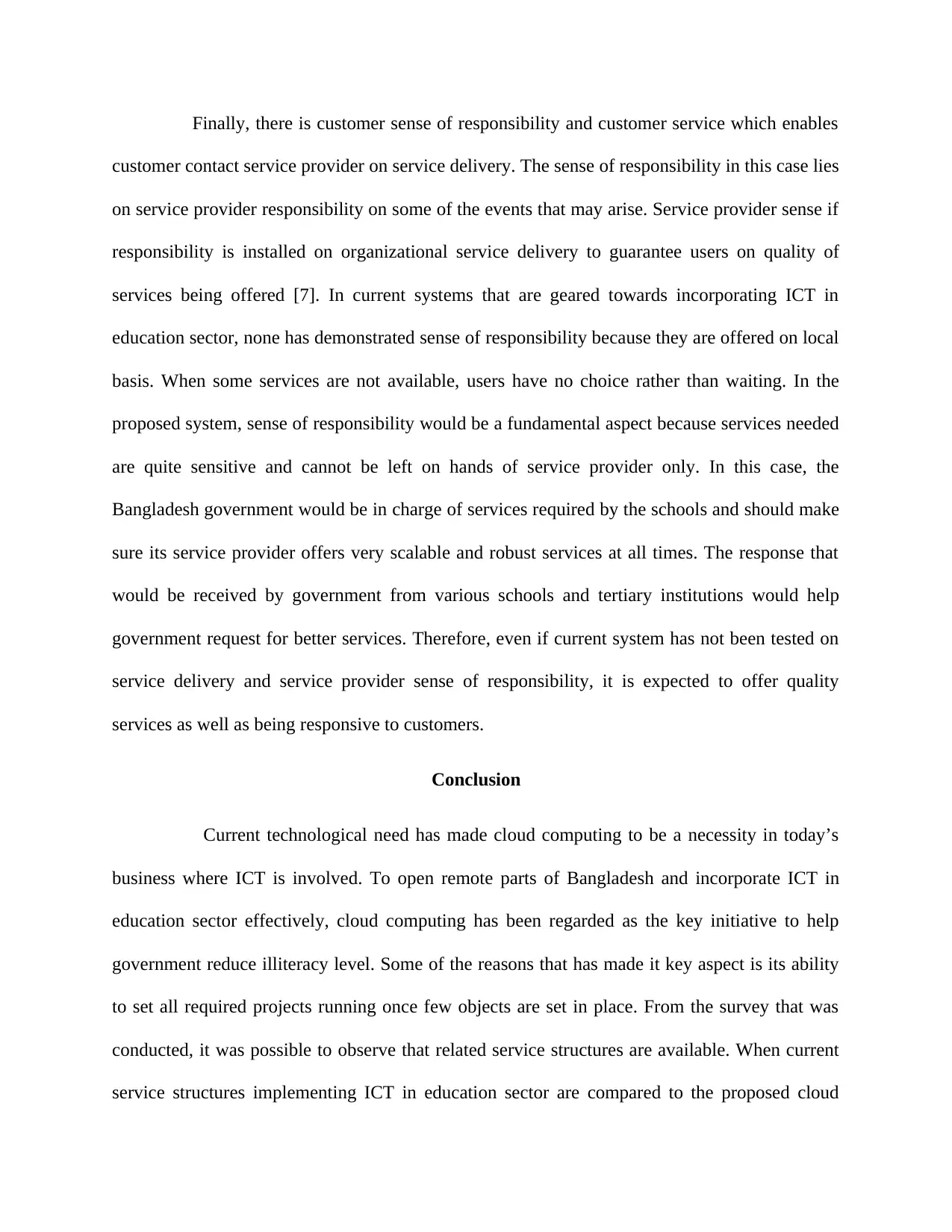
Finally, there is customer sense of responsibility and customer service which enables
customer contact service provider on service delivery. The sense of responsibility in this case lies
on service provider responsibility on some of the events that may arise. Service provider sense if
responsibility is installed on organizational service delivery to guarantee users on quality of
services being offered [7]. In current systems that are geared towards incorporating ICT in
education sector, none has demonstrated sense of responsibility because they are offered on local
basis. When some services are not available, users have no choice rather than waiting. In the
proposed system, sense of responsibility would be a fundamental aspect because services needed
are quite sensitive and cannot be left on hands of service provider only. In this case, the
Bangladesh government would be in charge of services required by the schools and should make
sure its service provider offers very scalable and robust services at all times. The response that
would be received by government from various schools and tertiary institutions would help
government request for better services. Therefore, even if current system has not been tested on
service delivery and service provider sense of responsibility, it is expected to offer quality
services as well as being responsive to customers.
Conclusion
Current technological need has made cloud computing to be a necessity in today’s
business where ICT is involved. To open remote parts of Bangladesh and incorporate ICT in
education sector effectively, cloud computing has been regarded as the key initiative to help
government reduce illiteracy level. Some of the reasons that has made it key aspect is its ability
to set all required projects running once few objects are set in place. From the survey that was
conducted, it was possible to observe that related service structures are available. When current
service structures implementing ICT in education sector are compared to the proposed cloud
customer contact service provider on service delivery. The sense of responsibility in this case lies
on service provider responsibility on some of the events that may arise. Service provider sense if
responsibility is installed on organizational service delivery to guarantee users on quality of
services being offered [7]. In current systems that are geared towards incorporating ICT in
education sector, none has demonstrated sense of responsibility because they are offered on local
basis. When some services are not available, users have no choice rather than waiting. In the
proposed system, sense of responsibility would be a fundamental aspect because services needed
are quite sensitive and cannot be left on hands of service provider only. In this case, the
Bangladesh government would be in charge of services required by the schools and should make
sure its service provider offers very scalable and robust services at all times. The response that
would be received by government from various schools and tertiary institutions would help
government request for better services. Therefore, even if current system has not been tested on
service delivery and service provider sense of responsibility, it is expected to offer quality
services as well as being responsive to customers.
Conclusion
Current technological need has made cloud computing to be a necessity in today’s
business where ICT is involved. To open remote parts of Bangladesh and incorporate ICT in
education sector effectively, cloud computing has been regarded as the key initiative to help
government reduce illiteracy level. Some of the reasons that has made it key aspect is its ability
to set all required projects running once few objects are set in place. From the survey that was
conducted, it was possible to observe that related service structures are available. When current
service structures implementing ICT in education sector are compared to the proposed cloud
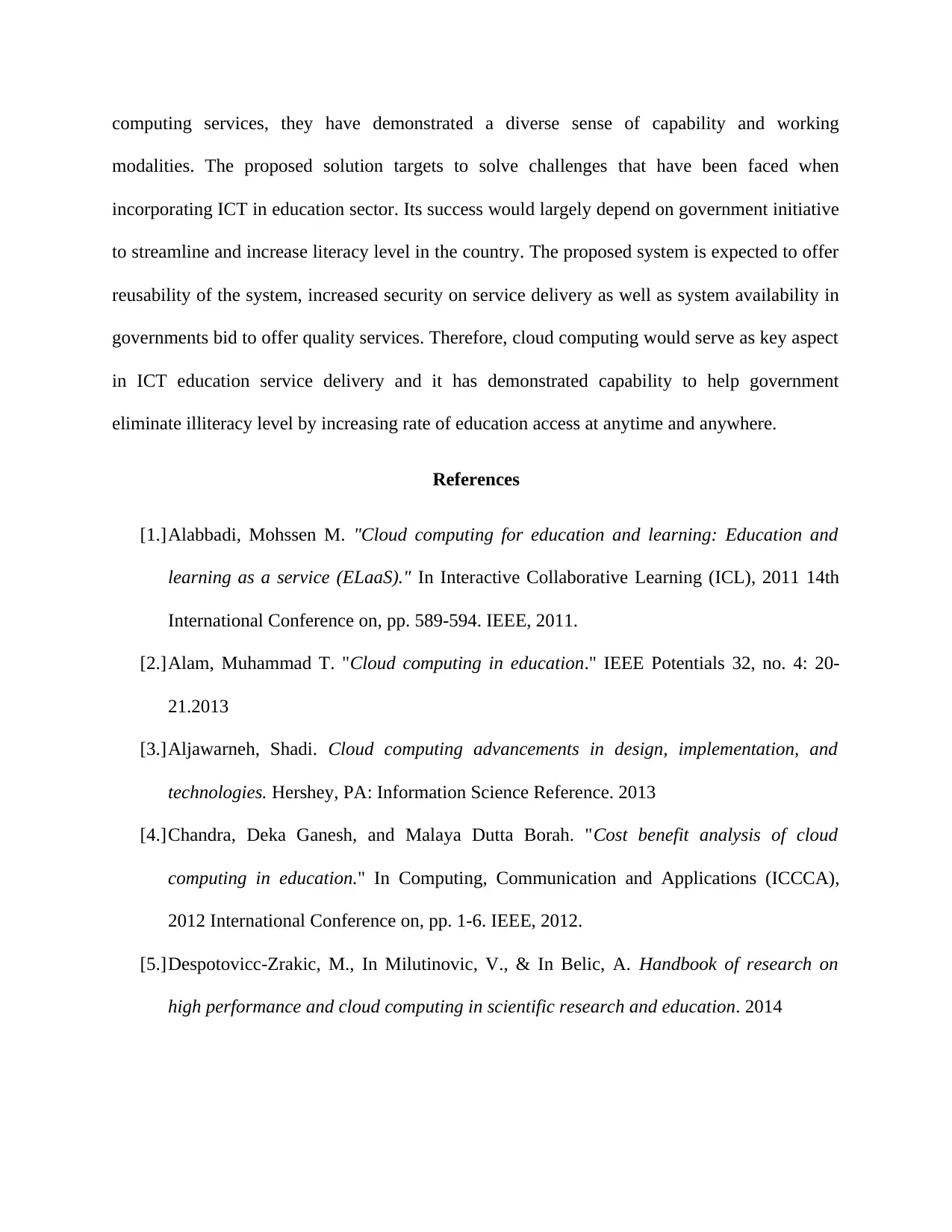
computing services, they have demonstrated a diverse sense of capability and working
modalities. The proposed solution targets to solve challenges that have been faced when
incorporating ICT in education sector. Its success would largely depend on government initiative
to streamline and increase literacy level in the country. The proposed system is expected to offer
reusability of the system, increased security on service delivery as well as system availability in
governments bid to offer quality services. Therefore, cloud computing would serve as key aspect
in ICT education service delivery and it has demonstrated capability to help government
eliminate illiteracy level by increasing rate of education access at anytime and anywhere.
References
[1.]Alabbadi, Mohssen M. "Cloud computing for education and learning: Education and
learning as a service (ELaaS)." In Interactive Collaborative Learning (ICL), 2011 14th
International Conference on, pp. 589-594. IEEE, 2011.
[2.]Alam, Muhammad T. "Cloud computing in education." IEEE Potentials 32, no. 4: 20-
21.2013
[3.]Aljawarneh, Shadi. Cloud computing advancements in design, implementation, and
technologies. Hershey, PA: Information Science Reference. 2013
[4.]Chandra, Deka Ganesh, and Malaya Dutta Borah. "Cost benefit analysis of cloud
computing in education." In Computing, Communication and Applications (ICCCA),
2012 International Conference on, pp. 1-6. IEEE, 2012.
[5.]Despotovicc-Zrakic, M., In Milutinovic, V., & In Belic, A. Handbook of research on
high performance and cloud computing in scientific research and education. 2014
modalities. The proposed solution targets to solve challenges that have been faced when
incorporating ICT in education sector. Its success would largely depend on government initiative
to streamline and increase literacy level in the country. The proposed system is expected to offer
reusability of the system, increased security on service delivery as well as system availability in
governments bid to offer quality services. Therefore, cloud computing would serve as key aspect
in ICT education service delivery and it has demonstrated capability to help government
eliminate illiteracy level by increasing rate of education access at anytime and anywhere.
References
[1.]Alabbadi, Mohssen M. "Cloud computing for education and learning: Education and
learning as a service (ELaaS)." In Interactive Collaborative Learning (ICL), 2011 14th
International Conference on, pp. 589-594. IEEE, 2011.
[2.]Alam, Muhammad T. "Cloud computing in education." IEEE Potentials 32, no. 4: 20-
21.2013
[3.]Aljawarneh, Shadi. Cloud computing advancements in design, implementation, and
technologies. Hershey, PA: Information Science Reference. 2013
[4.]Chandra, Deka Ganesh, and Malaya Dutta Borah. "Cost benefit analysis of cloud
computing in education." In Computing, Communication and Applications (ICCCA),
2012 International Conference on, pp. 1-6. IEEE, 2012.
[5.]Despotovicc-Zrakic, M., In Milutinovic, V., & In Belic, A. Handbook of research on
high performance and cloud computing in scientific research and education. 2014
⊘ This is a preview!⊘
Do you want full access?
Subscribe today to unlock all pages.

Trusted by 1+ million students worldwide
1 out of 14
Related Documents
Your All-in-One AI-Powered Toolkit for Academic Success.
+13062052269
info@desklib.com
Available 24*7 on WhatsApp / Email
![[object Object]](/_next/static/media/star-bottom.7253800d.svg)
Unlock your academic potential
Copyright © 2020–2025 A2Z Services. All Rights Reserved. Developed and managed by ZUCOL.





